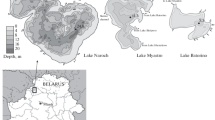Abstract
Lake Neuchâtel (Switzerland), oligotrophic until 1950, was meso-eutrophic in 1980. The relative abundance in worm communities of Peloscolex velutinus and Stylodrilus heringianus was used to monitor the trophic state of the lake. In 1980, the median relative abundance of these oligotrophic species was 9% in the whole of Lake Neuchâtel compared with 70% in oligotrophic lakes, 35% in mesotrophic lakes, and 0% in eutrophic lakes. The scarcity of oligotrophic species in the deepest area (153 m) characterized better the meso-eutrophic state of Lake Neuchâtel than oxygen concentrations which never descended below 6 mg·1-1. Location of the area within the lake from where worms were sampled was of critical importance to assess the trophic state: some areas reflected the past rather than the present state of the lake.
Similar content being viewed by others
References
Binford, M. W. & M. Brenner, 1986. Dilution of 210Pb by organic sedimentation in lakes of different trophic states, and application to studies of sediment-water interactions. Limnol. Oceanogr. 31: 584–595.
Cook, D. G., 1975. A preliminary report on the benthic macroinvertebrates of Lake Superior. Fish. Mar. Serv. Tech. rept. 572.
Lang, C., 1984. Eutrophication of Lakes Léman and Neuchâtel (Switzerland) indicated by oligochaete communities. Hydrobiologia 115: 131–138.
Lang, C., 1985. Eutrophication of Lake Geneva indicated by the oligochaete communities of the profundal. Hydrobiologia 126: 237–243.
Lang, C., 1986. Eutrophisation du Léman indiquée par les communautés d'oligochètes: campagnes 1982–1985. Schweiz. Z. Hydrol. 48: 230–239.
Lang, C. & P. Hutter, 1981. Structure, diversity and stability of two oligochaete communities according to sedimentary inputs in Lake Geneva (Switzerland). Schweiz. Z. Hydrol. 43: 265–276.
Monard, A., 1919. La faune profonde du lac de Neuchâtel. Thèse Univ. Neuchâtel. 176 pp.
Nalepa, T. F., M. A. Quigley, K. F. Childs, J. M. Gauvin, T. S. Heatlie, M. P. Parker & L. Vanover 1985. Macrobenthos of southern Lake Michigan, 1980–81. NOAA, Data report ERL GLERL -28.
Pelletier, J., 1983. Evaluation de la production primaire ou production organique dans le Léman. Rapp. Comm. int. Prot. Eaux Léman contre Pollution. 208 pp.
Piguet, E. & K. Bretscher, 1913. Oligochètes. Catalogue des invertébrés de la Suisse. Georg & Cie, Genève, 215 pp
Pokorni, B., 1983. Evaluation de létat sanitaire du lac de Neuchâtel (Baie d'Auvernier) de 1975 à 1980. Rapp. service protection environment, Neuchâtel. 43 pp.
Pokorni, B., 1984. Etat sanitaire du lac de Neuchâtel en 1982 et 1983. Rapp. service protection environment, Neuchâtel. 46 pp.
Reckhow, K. H., 1980. Techniques for exploring and presenting data applied to lake phosphorus concentrations. Can. J. Fish. Aquat. Sci. 37: 290–294.
Sollberger, H., 1974. Le lac de Neuchâtel (Suisse). Ses eaux, ses sédiments, ses courants sous-lacustres. Thèse Univ. Neuchâtel. 415 pp.
Vollenweider, R. A., M. Munawar & P. Stadelmann, 1974. A comparative review of phytoplankton and primary production in the Laurential Great Lakes. J. Fish. Res. Bd Can. 31: 739–762.
Author information
Authors and Affiliations
Rights and permissions
About this article
Cite this article
Lang, C. Eutrophication of Lake Neuchâtel indicated by the oligochaete communities. Hydrobiologia 174, 57–65 (1989). https://doi.org/10.1007/BF00006058
Received:
Revised:
Accepted:
Issue Date:
DOI: https://doi.org/10.1007/BF00006058




